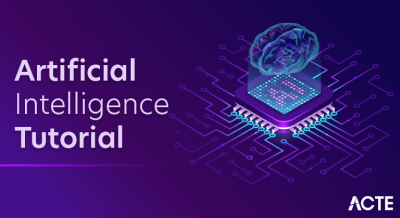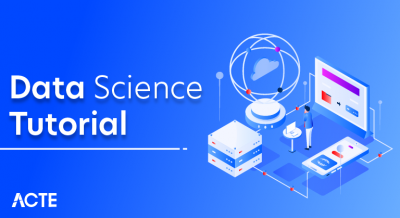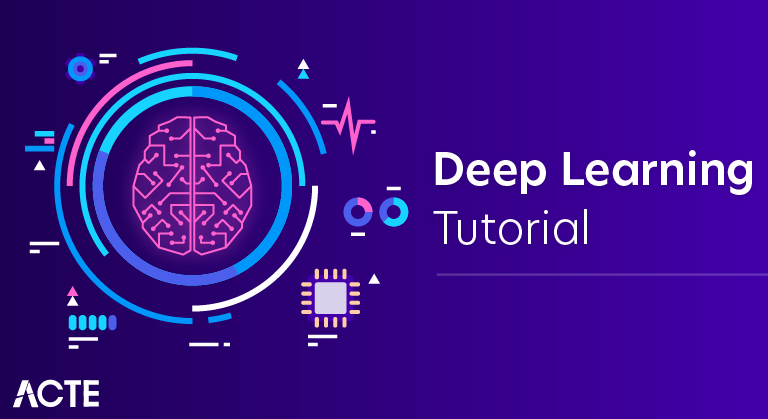
What is Deep Learning?
Deep learning is a computer software that mimics the network of neurons in a brain. It is a subset of machine learning and is called deep learning because it makes use of deep neural networks.
Deep learning algorithms are constructed with connected layers.
- The first layer is called the Input Layer
- The last layer is called the Output Layer
- All layers in between are called Hidden Layers. The word deep means the network joins neurons in more than two layers.
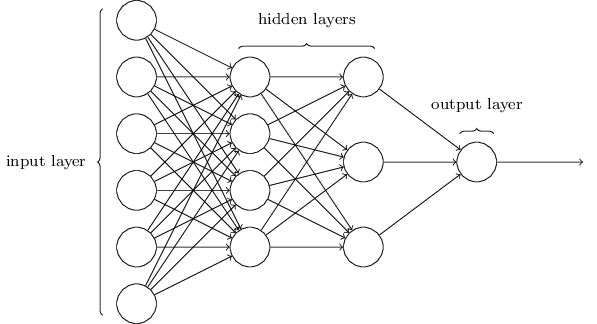
Each Hidden layer is composed of neurons. The neurons are connected to each other. The neuron will process and then propagate the input signal it receives the layer above it. The strength of the signal given the neuron in the next layer depends on the weight, bias and activation function.
The network consumes large amounts of input data and operates them through multiple layers; the network can learn increasingly complex features of the data at each layer.
In this training, you will learn
- What is Deep Learning?
- Deep learning Process
- Classification of Neural Networks
- Types of Deep Learning Networks
- Feed-forward neural networks
- Recurrent neural networks (RNNs)
- Convolutional neural networks (CNN)
- Reinforcement Learning
- Examples of deep learning applications
- Why is Deep Learning Important?
- Limitations of deep learning
Deep learning Process:
A deep neural network provides state-of-the-art accuracy in many tasks, from object detection to speech recognition. They can learn automatically, without predefined knowledge explicitly coded by the programmers.
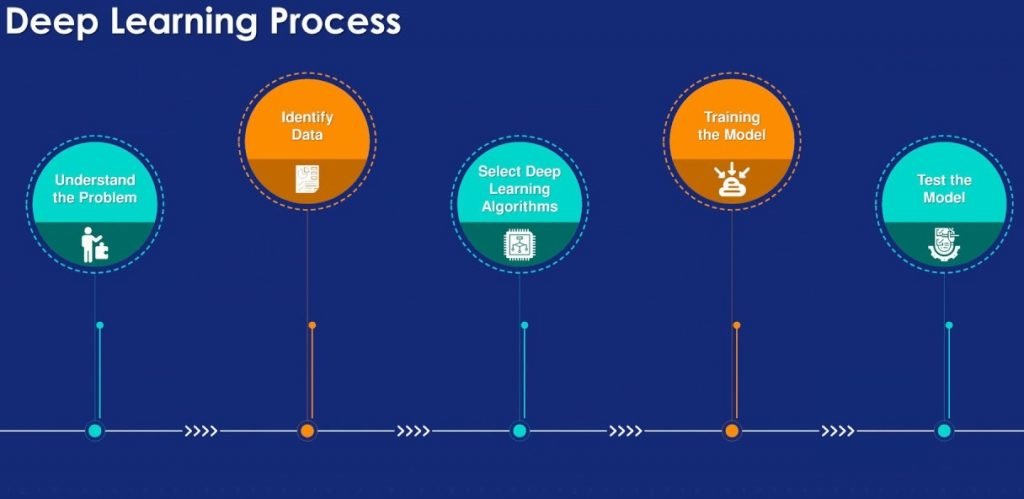
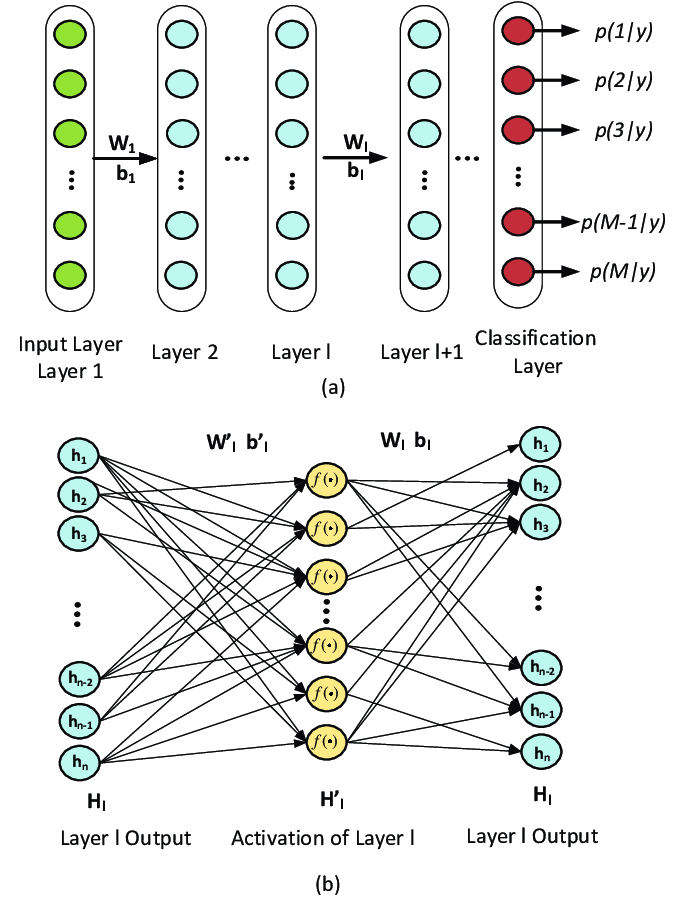
To grasp the idea of deep learning, imagine a family, with an infant and parents. The toddler points objects with his little finger and always says the word ‘cat.’ As its parents are concerned about his education, they keep telling him ‘Yes, that is a cat’ or ‘No, that is not a cat.’ The infant persists in pointing objects but becomes more accurate with ‘cats.’ The little kid, deep down, does not know why he can say it is a cat or not. He has just learned how to hierarchize complex features coming up with a cat by looking at the pet overall and continue to focus on details such as the tails or the nose before to make up his mind.
A neural network works quite the same. Each layer represents a deeper level of knowledge, i.e., the hierarchy of knowledge. A neural network with four layers will learn more complex features than with that with two layers.
The learning occurs in two phases.
- The first phase consists of applying a nonlinear transformation of the input and creating a statistical model as output.
- The second phase aims at improving the model with a mathematical method known as derivative.
The neural network repeats these two phases hundreds to thousands of times until it has reached a tolerable level of accuracy. The repeat of this two-phase is called an iteration.
To give an example, take a look at the motion below, the model is trying to learn how to dance. After 10 minutes of training, the model does not know how to dance, and it looks like a scribble.
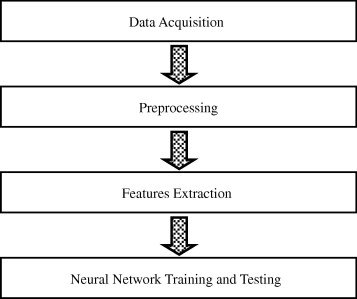
After 48 hours of learning, the computer masters the art of dancing.Deep neural network: Deep neural networks have more than one layer. For instance, Google LeNet model for image recognition counts 22 layers.Nowadays, deep learning is used in many ways like a driverless car, mobile phone, Google Search Engine, Fraud detection, TV, and so on.
Types of Deep Learning Networks:
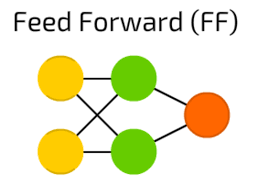
Feed-forward neural networks:
The simplest type of artificial neural network. With this type of architecture, information flows in only one direction, forward. It means, the information’s flow starts at the input layer, goes to the “hidden” layers, and ends at the output layer. The network does not have a loop. Information stops at the output layers.
Recurrent neural networks (RNNs):
RNN is a multi-layered neural network that can store information in context nodes, allowing it to learn data sequences and output a number or another sequence. In simple words it is an Artificial neural network whose connections between neurons include loops. RNNs are well suited for processing sequences of inputs.
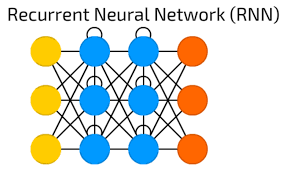
Example, if the task is to predict the next word in the sentence “Do you want?”
- The RNN neurons will receive a signal that points to the start of the sentence.
- The network receives the word “Do” as an input and produces a vector of the number. This vector is fed back to the neuron to provide a memory to the network. This stage helps the network to remember it received “Do” and it received it in the first position.
- The network will similarly proceed to the next words. It takes the word “you” and “want.” The state of the neurons is updated upon receiving each word.
- The final stage occurs after receiving the word “a.” The neural network will provide a probability for each English word that can be used to complete the sentence. A well-trained RNN probably assigns a high probability to “café,” “drink,” “burger,” etc.
Common uses of RNN:
- Help securities traders to generate analytic reports
- Detect abnormalities in the contract of financial statement
- Detect fraudulent credit-card transaction
- Provide a caption for images
- Power chatbots
- The standard uses of RNN occur when the practitioners are working with time-series data or sequences (e.g., audio recordings or text).
Convolutional neural networks (CNN):
CNN is a multi-layered neural network with a unique architecture designed to extract increasingly complex features of the data at each layer to determine the output. CNN’s are well suited for perceptual tasks.
CNN is mostly used when there is an unstructured data set (e.g., images) and the practitioners need to extract information from it
For instance, if the task is to predict an image caption:
- The CNN receives an image of let’s say a cat, this image, in computer terms, is a collection of the pixels. Generally, one layer for the greyscale picture and three layers for a color picture.
- During the feature learning (i.e., hidden layers), the network will identify unique features, for instance, the tail of the cat, the ear, etc.
- When the network thoroughly learns how to recognize a picture, it can provide a probability for each image it knows. The label with the highest probability will become the prediction of the network.
Reinforcement Learning:
Reinforcement learning is a subfield of machine learning in which systems are trained by receiving virtual “rewards” or “punishments,” essentially learning by trial and error. Google’s DeepMind has used reinforcement learning to beat a human champion in the Go games. Reinforcement learning is also used in video games to improve the gaming experience by providing smarter bot.
One of the most famous algorithms are:
- Q-learning
- Deep Q network
- State-Action-Reward-State-Action (SARSA)
- Deep Deterministic Policy Gradient (DDPG)
Examples of deep learning applications:
AI in Finance: The financial technology sector has already started using AI to save time, reduce costs, and add value. Deep learning is changing the lending industry by using more robust credit scoring. Credit decision-makers can use AI for robust credit lending applications to achieve faster, more accurate risk assessment, using machine intelligence to factor in the character and capacity of applicants.Underwrite is a Fintech company providing an AI solution for credit makers. underwrite.ai uses AI to detect which applicant is more likely to pay back a loan. Their approach radically outperforms traditional methods.
AI in HR: Under Armour, a sportswear company revolutionizes hiring and modernizes the candidate experience with the help of AI. In fact, Under Armour Reduces hiring time for its retail stores by 35%. Under Armour faced a growing popularity interest back in 2012. They had, on average, 30000 resumes a month. Reading all of those applications and beginning the screening and interview process was taking too long. The lengthy process to get people hired and on-boarded impacted Under Armour’s ability to have their retail stores fully staffed, ramped and ready to operate.At that time, Under Armour had all of the ‘must have’ HR technology in place such as transactional solutions for sourcing, applying, tracking and onboarding but those tools weren’t useful enough. Under armour choose HireVue, an AI provider for HR solution, for both on-demand and live interviews. The results were bluffing; they managed to decrease by 35% the time to fill. In return, they hired higher quality staff.AI in Marketing: AI is a valuable tool for customer service management and personalization challenges. Improved speech recognition in call-center management and call routing as a result of the application of AI techniques allows a more seamless experience for customers.
For example, deep-learning analysis of audio allows systems to assess a customer’s emotional tone. If the customer is responding poorly to the AI chatbot, the system can reroute the conversation to real, human operators that take over the issue.
Apart from the three examples above, AI is widely used in other sectors/industries.
Why is Deep Learning Important?
Deep learning is a powerful tool to make prediction an actionable result. Deep learning excels in pattern discovery (unsupervised learning) and knowledge-based prediction. Big data is the fuel for deep learning. When both are combined, an organization can reap unprecedented results in terms of productivity, sales, management, and innovation.Deep learning can outperform traditional methods. For instance, deep learning algorithms are 41% more accurate than machine learning algorithms in image classification, 27 % more accurate in facial recognition and 25% in voice recognition.
Limitations of deep learning:
Data labeling:
Most current AI models are trained through “supervised learning.” It means that humans must label and categorize the underlying data, which can be a sizable and error-prone chore. For example, companies developing self-driving-car technologies are hiring hundreds of people to manually annotate hours of video feeds from prototype vehicles to help train these systems.
Obtain huge training datasets:
It has been shown that simple deep learning techniques like CNN can, in some cases, imitate the knowledge of experts in medicine and other fields. The current wave of machine learning, however, requires training data sets that are not only labeled but also sufficiently broad and universal.Deep-learning methods require thousands of observations for models to become relatively good at classification tasks and, in some cases, millions for them to perform at the level of humans. Without surprise, deep learning is famous in giant tech companies; they are using big data to accumulate petabytes of data. It allows them to create an impressive and highly accurate deep learning model.
Explain a problem:
Large and complex models can be hard to explain, in human terms. For instance, why a particular decision was obtained. It is one reason that acceptance of some AI tools are slow in application areas where interpretability is useful or indeed required.Furthermore, as the application of AI expands, regulatory requirements could also drive the need for more explainable AI models.Deep learning is the new state-of-the-art for artificial intelligence. Deep learning architecture is composed of an input layer, hidden layers, and an output layer. The word deep means there are more than two fully connected layers.There is a vast amount of neural networks, where each architecture is designed to perform a given task. For instance, CNN works very well with pictures, RNN provides impressive results with time series and text analysis.Deep learning is now active in different fields, from finance to marketing, supply chain, and marketing. Big firms are the first one to use deep learning because they already have a large pool of data. Deep learning requires an extensive training dataset.
Uses:
Top Applications of Deep Learning Across Industries
- Self Driving Cars.
- News Aggregation and Fraud News Detection.
- Natural Language Processing.
- Virtual Assistants.
- Entertainment.
- Visual Recognition.
- Fraud Detection.
- Healthcare.
Advantages of Deep Learning:
One of deep learning’s main advantages over other machine learning algorithms is its capacity to execute feature engineering on its own. A deep learning algorithm will scan the data to search for features that correlate and combine them to enable faster learning without being explicitly told to do so.
Drawbacks or disadvantages of Deep Learning:
- It requires a very large amount of data in order to perform better than other techniques.
- It is extremely expensive to train due to complex data models. Moreover deep learning requires expensive GPUs and hundreds of machines. This increases cost to the users.
Conclusion:
Deep Learning Is Undeniably Mind-BlowingNeural networks were invented in the 60s, but recent boosts in big data and computational power made them actually useful. A new discipline called “deep learning” arose and applied complex neural network architectures to model patterns in data more accurately than ever before.Hope you have found all the details that you were looking for, in this article.


